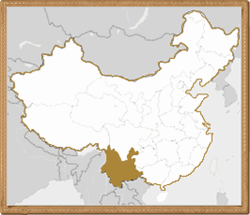Young Pu-erh
Famed for its health properties and having a character described as elemental, musty and with dank earthy tones.
During the 1200's the troops of Kubla Khan are said to have introduced Pu-erh to the rest of China for its medicinal value. Pu-erh is often taken for relief of indigestion and dysentery but has also been reported as very useful in the reduction of cholesterol.
The leaves come from the Yunnan Dayeh variety of tea tree - which is purported to be closely related to the original tea tree of pre-glacial times.
Yunnan Province/China

Studies in Japan indicated that all tea lowered cholesterol and that Pu-erh was more effective than green tea. Chinese tea for health report that Pu-erh can; “cut the grease, help digestion, promote body fluid secretion, quench the thirst, invigorate the spleen and dispel alcoholic toxins" How effective Pu-erh is for the various claims that researchers and tea drinkers make have not been firmly established by medical professionals, but we know of family, friends and hundreds of customers who are convinced!, what is certain is that Pu-erh is rather unusual and has properties many other teas do not share.
The method of production is:
The leaves are picked, rolled, withered in the hot sun, after which they are steamed and pressed into cakes. This Pu-erh is broken up out of the cakes to make it easier to deal with. The steaming process generates some moisture and when compressed (without drying) into the cakes, in the course of time the tea takes on a musty and earthy character. Pu-erh that gets somewhat mouldy before it naturally dries is considered the best. Pu-erh is then stored for years. As with wine, young Pu-erh is considered the least valuable whereas Pu-erh 5 years or older is more highly prized. The taste of Pu-erh becomes more mellow with age and perhaps more acceptable to the western palate.
The flavour has been described as mellow, however, those not accustomed to it might not enjoy the old character.
The leaves are picked, rolled, withered in the hot sun, after which they are steamed and pressed into cakes. This Pu-erh is broken up out of the cakes to make it easier to deal with. The steaming process generates some moisture and when compressed (without drying) into the cakes, in the course of time the tea takes on a musty and earthy character. Pu-erh that gets somewhat mouldy before it naturally dries is considered the best. Pu-erh is then stored for years. As with wine, young Pu-erh is considered the least valuable whereas Pu-erh 5 years or older is more highly prized. The taste of Pu-erh becomes more mellow with age and perhaps more acceptable to the western palate.
The flavour has been described as mellow, however, those not accustomed to it might not enjoy the old character.
The flavour will add to its aura of wonder and seem fitting in a tea prized for its medicinal properties, it is well worthy of a place in any collection.
Origin: China
Ingredients: Black tea (Pu-erh style)
Region: Yunnan Province
Caffeine Guide: Medium
Growing Altitudes: 1500 – 4900 feet above sea level
Antioxidant Content: Medium
Grade: Pu-erh 1 year vintage
Infusion Colour: Dull, black
Process: Special Pu-erh process, Handcrafted.
